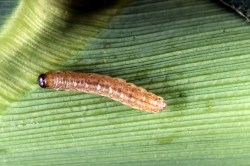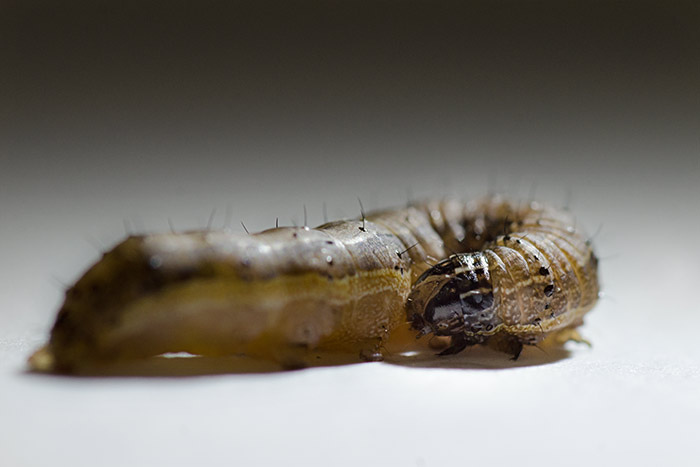
Richardus_HSpodoptera frugiperda gained resistance to genetically engineered corn in Puerto Rico in just three years.
I’ve finally worked my way around to the GMO question that I care about most: Are genetically modified crops boon or bane for the environment?
The answer is big enough, and important enough, that it’s going to take me two posts — one for each of the two main groups of genetically engineered food crops. Today, I’ll look at the environmental fallout from plants genetically altered for pest resistance. Next, I’ll look at the effects of plants engineered for herbicide tolerance. (Herbicide tolerance is related to soil quality, and the government shutdown has cut me off from much of the soil information I’d hoped to gather, so bear with me.) These two areas are quite different, so we can’t draw any conclusions until we’ve completed looking at both of them.
When I started asking about environmental effects, several experts who take a critical view of GMOs pointed me to an entomologist at the University of Arizona named Bruce Tabashnik. Yet Tabashnik was surprisingly upbeat: So far, he said, insect-resistant plants have been a clear win for the environment. “Because of them, we’re running the pesticide treadmill in reverse,” he said.
The pesticide treadmill describes a problem that consistently occurs in agriculture. It goes like this: Eventually, insects evolve resistance to an insecticide, so the farmer starts using more sprays or something more toxic. But this can kill all the critters in the fields — not just the pests, but also the predators that eat the pests. Then the problem gets much worse. As time passes the farmer becomes more and more dependent on chemicals as the only means of pest control, using larger amounts, or more severe poisons, and getting less benefit.
But transgenic insect-resistant crops have turned this process around, Tabashnik says. These plants produce proteins from a widespread bacterium known as Bt (Bacillus thuringiensis) that only harm a narrow set of insects. Bt itself is widely used as an insecticide, mostly by organic farmers. Because the Bt-producing crops kill some key pests, farmers spray less insecticide to control those pests. This allows beneficial insects to survive. With more insect predators there’s less need for insecticides, and when farmers do spray, the insecticides work better.
The practice of using pesticides strategically and sparingly, alongside other techniques like nurturing greater diversity, is called integrated pest management, or IPM. In some places, such at the cotton fields of Arizona, plants genetically engineered for insect resistance “have become the cornerstone of IPM. It’s difficult to do IPM when you are spraying often with broad-spectrum insecticides,” Tabashnik said.
As farmers adopt integrated pest management, they’ve achieved impressive results, Tabashnik said. In Arizona, insecticide applications on cotton have dropped 80 percent thanks to this changeover. But, he said, “that’s one of the most dramatic reductions you’ll find with a Bt crop anywhere in the world.”
There are other cases — in the Chinese struggle with the cotton bollworm, for instance — where insect-resistant crops have not even led to a 25 percent drop in insecticides. This may be because there are secondary pests, unaffected by Bt, which boom to fill the bollworm niche. Or it could be something else: Researchers have documented cases in which Chinese farmers used just as much insecticides on Bt plants as conventional fields, perhaps because they weren’t sure they’d been sold the real thing, or because they didn’t understand how Bt worked.
Nonetheless, even small reductions in insecticides have led to big increases in beneficial insects in China, according to one study.
There’s broad agreement that, so far, GMOs have helped the environment by cutting use of chemical insecticides. It’s clear that Bt plants have led to decreases in spraying, said Marcia Ishii-Eiteman, senior scientist at the Pesticide Action Network. “But,” she quickly added, “as was predicted 10 years ago, we are starting to see the insect resistance to Bt.”
Bill Freese at the Center for Food Safety also downplayed the importance of genetic engineering in reducing insecticides. “If you just look at the first 10 years or so that’s true,” he said. “After that short amount of time, it starts going up again.”
There have been some true disasters, Tabashnik agrees: In Puerto Rico insects became nearly impervious to Bt corn in just three years. But, on the other hand, there are cases like the European corn borer, which remains completely susceptible to Bt, giving corn farmers in the Midwest billions in increased yield. And then there’s everything in between: Tabashnik was the lead author on a recent paper that examined the spread of Bt resistance; there are 11 cases where it’s still working great, five others where it’s failed, and still others where insects have gained partial resistance.

Keith WellerEuropean corn borer, Ostrinia nubilalis.
Some insects are inherently more vulnerable to the Bt toxins. If Bt kills almost all the pests, it’s hard for them to develop resistance, Tabashnik said. “But even if you have 2 percent survival — which doesn’t seem like a lot — then you have to watch out.” It you kill off all but those invulnerable 2 percent, they will mate and make thousands of resistant babies. The way to fight this is to mix it up: Farm with both Bt and conventional plants, so that there are plenty of vulnerable insects to dilute the gene pool.
In cases where 2 percent or more insects survive the Bt toxin, Tabashnik thinks farmers should be planting something like 50 percent conventional crops to stave off resistance. Instead, they are often planting just 5 percent conventional seed. “That 5 percent makes sense if your priority is to make money this year,” he said. But in the long term, it doesn’t make any sense for postponing the evolution of resistance.”
The biotech people would say that they just need to prevent Bt resistance long enough to come up with something better: Already they are selling plants that produce two different types of the Bt toxin at once. And there is always the promise of new kinds of insect resistance down the road.
But these things take time, and it’s a shame to be wearing out Bt when it has allowed so many farmers to embrace integrated pest management. The tragedy will be even greater for organic farmers who have long relied on Bt sprays, as those sprays become less effective because there are more resistant insects.
In asking who has benefited from GM crops, I’ve been trying to stick to the facts, rather than projecting scenarios into the future. And the facts suggest that, as Tabashnik says, Bt plants have done a lot of good, to date: Insecticide use is trending downward in the U.S. And the use of organophosphates (a nastier class of insecticide) fell 55 percent between 1997 and 2007. The widespread adoption of insect-resistant transgenics has surely helped in this reduction.
Now I’ll turn to herbicide-tolerant plants, where the picture is cloudier.
More in this series:
- The genetically modified food debate: Where do we begin?
- The GM safety dance: What’s rule and what’s real
- Genetic engineering vs. natural breeding: What’s the difference?
- Is nature a cradle or a battlefield?
- Genetically engineered food: Allergic to regulations?
- Genetically modified seed research: What’s locked and what isn’t
- Is extremism in defense of GM food a vice?
- Elephant in the room: Why getting the GMO story straight is so hard
- Food for bots: Distinguishing the novel from the knee-jerk in the GMO debate
- Pointed talk: Michael Pollan and Amy Harmon dissect a GM controversy
- Golden Rice: Fool’s gold or golden opportunity?
- Golden apple or forbidden fruit? Following the money on GMOs
Correction: This article originally quoted Pesticide Action Network’s Dr. Marcia Ishii-Eiteman as saying that Bt plants had led to vast decreases in spraying. We have changed this line by removing the word “vast,” an imprecise and subjective term which does not accurately reflect Dr. Ishii-Eiteman’s statement.



